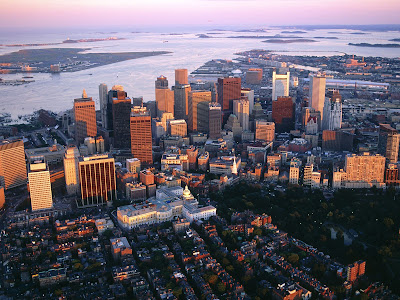 |
| Reverend William Blackstone Reverend William Blackstone was the first English immigrant who settled in Boston in 1629. The following year, John Winthrop and his Puritan settlers of the Massachusetts Bay Colony settled at Boston. This location was called Shawmut by the local Algonquin inhabitants at that time. On September 17, 1630, Winthrop decided to shift to Shawmut permanently and renamed it as Boston. The church members controlled citizenship in Massachusetts until 1664. Rebels like Anne Hutchinson and Roger Williams were banished by the church. But despite these facts, representative institutions were establishing in the colony, laying the stone for its future as an established democratic nation. Algonquin inhabitants Puritans Puritan way of life was more prevalent in Boston for the next two centuries. It emerged as a center for education and learning with the arrival of legendary theologians and statesmen. The famous educational institutions like the Boston Latin School and Harvard University were established during this period. Stephen Daye constructed the first printing press in the colonies in 1639. The Boston manufacturers profited from the Civil War as they produced shoes, blankets, weapons, and other articles for the troops. Boston also actively participated in the abolitionist movement. It was a major turning point in the history of Boston in the late 19th century, when it established itself as the greatest industrial city. Boston Latin School 1935 Population According to the 2000 United States Census, there were 589,141 people, 239,528 households, and 115,212 families residing in the city. The population density was 12,166 people per square mile (4,697/km²). There were 251,935 housing units at an average density of 5,203 per square mile (2,009/km²). The 2009 U.S. Census population estimate for the city is 645,169, an 8.7% increase from 2000. During weekdays, the population of Boston can grow during the daytime to over 1.2 million, and can reach as many as 2 million during special events. This fluctuation of people is caused by hundreds of thousands of suburban residents who travel to the city for work, health care, special events, and education. According to the 2006-2008 American Community Survey, the racial composition of Boston was as follows: • White: 56.3% (Non-Hispanic Whites: 50.6%) • Black or African American: 23.5% • Native American: 0.4% • Asian: 8.2% • Native Hawaiian and Other Pacific Islander: 0.1% • Some other race: 8.5% • Two or more races: 3.1% • Hispanic or Latino (of any race): 16.1% Dialect In the U.S, the "Boston accent" is widely parodied as the speech of the Kennedys. It is non-rhotic (i.e., drops the "r" sound at the end of syllables unless the next syllable starts with a vowel) and traditionally uses a "broad a" in certain words, so "bath" can sound like "bahth." Boston English has many dialect words, such as "frappe," meaning "milkshake made with ice cream." The accent originated in the non-rhotic speech of 17th century East Anglia and Lincolnshire. Want to hear a Bostonian talk? Click here |
CHAPTER 3: Foundations of Human Activity
CHAPTER 2: Physical Environment
 |
Source: jsc.nasa.gov |
Boston’s total area: 232.1 square kilometer
Land area: 41.2 square kilometers
Area covered by water: 106.7 kilometers
Geographical Coordinates of Boston: 42.358N and 71.06W
Boston is located on the Shawmut Peninsula, found in the merging of the two rivers: Charles and Mystic rivers. The rivers flow into Boston's inner harbor and then into Boston Harbor itself. The hilly peninsula of Shawmut is entirely isolated from the mainland by marshy swamps. A planned and a compact city, Boston has an altitude of 5.8 meters above the sea level. Bellevue Hill, the highest point in the city, is 101 meters above the sea level.
The suburbs of Boston include the cities and towns of Winthrop, Everett, Somerville, Brookline, Needham, Canton, Milton and Quincy. Greater Boston is the name given to Boston and its suburbs. The Back Bay and the South End neighborhood of Boston are built on reclaimed land. The hills were leveled to fill in the marshlands.
River Charles separates the proper city from Cambridge, Watertown and Charlestown. The Neponset River in Boston separates the southern neighborhoods from the cities of Milton and Quincy. Mystic River determines the boundaries between Chelsea and Everett, while Boston harbor separates East Boston from the proper city.
Low rise brick or stone buildings, with Federal style architecture are found in Boston’s downtown and neighborhood areas. Modern high rise buildings are seen in South Boston Waterfront and Back Bay. Located in downtown, the Prudential Center and John Hancock Tower are two of the tallest buildings found here, which are major landmarks in Boston skyline.
Climate
Moderate climate is in between the months of April to September. Fog and humidity are by-products of Boston's proximity to water. Rain is frequent throughout the spring and summer, while snow falls regularly throughout the winter, making Boston one of the nation's wettest cities. Nearly 108 centimeters of snowfall are recorded annually in Boston. Atlantic Ocean breezes keep Boston's climate relatively mild compared to other cities in the northeastern United States. But those same Atlantic breezes help rank Boston among the country's windiest cities and occasionally blow into full-fledged storms called "nor'easters."
Average Temperatures: January, 29.3° F; July, 73.9° F; annual average, 51.6° FAverage Annual Precipitation: 42.53 inches of rain; 42.6 inches of snow
To learn more about Boston's climate, click here
Welcome to my blog
Subscribe to:
Posts (Atom)









